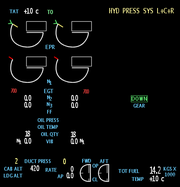
EICAS
Encyclopedia

Components
EICAS typically includes instrumentation of various engine parameters, including for example revolutions per minuteRevolutions per minute
Revolutions per minute is a measure of the frequency of a rotation. It annotates the number of full rotations completed in one minute around a fixed axis...
, temperature values, fuel flow and quantity, oil pressure etc. Typical other aircraft systems monitored by EICAS are for example hydraulic, pneumatic, electrical, deicing, environmental and control surface systems.
As EICAS has high connectivity, it provides data acquisition and routing.
EICAS is a key function of a glass cockpit
Glass cockpit
A glass cockpit is an aircraft cockpit that features electronic instrument displays, typically large LCD screens, as opposed to the traditional style of analog dials and gauges...
system, which replaces all analog gauges with software-driven electronic displays. Most of the display area is used for navigation and orientation displays, but one display or a section of a display is set aside specifically for EICAS.
The Crew Alerting System (CAS) is used in place of the annunciator panel
Annunciator panel
An annunciator panel is a group of lights used as a central indicator of status of equipment or systems in an aircraft, industrial process, building or other installation...
on older systems. Rather than signaling a system failure by turning on a light behind a translucent button, failures are shown as a list of messages in a small window near the other EICAS indications.
External links
- http://www.rockwellcollins.com/products/cs/br/avionics-systems/eicas/eicas/
- http://www.astronautics.com/index.php?q=content/engine-instrument-crew-alert-system-display

